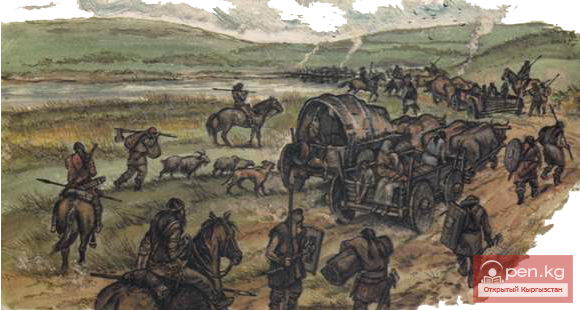Kyrgyz of Tajikistan
The Kyrgyz of Tajikistan are mainly settled in Pamir - in the Murghab District of the Gorno-Badakhshan Autonomous Region and in Khatlon - in the Jirgatal District of the Republic of Tajikistan. According to the 2000 census, there were 65.5 thousand ethnic Kyrgyz in Tajikistan, of which 2/3 are located in Khatlon (Jirgatol), and the rest in Pamir (Murghab).
Starting from the 16th century, waves of Kyrgyz migrants could repeatedly penetrate into Khatlon. In particular, Mahmud ibn Wali noted the passage of 12 thousand Kyrgyz families. According to V. V. Bartold, this event was likely associated with the settlement of Kyrgyz in Khatlon (Kislyakov, 1941, p. 66; Bartold, 1927, p. 39). According to legends widely spread among both Kyrgyz and Tajiks, Khatlon was once populated by a Turkic group - the Kyrgyz (Kislyakov, 1941, pp. 64-65). The Kyrgyz of Pamir and Khatlon are represented by large tribes such as Naymans, Teitis, Kipchaks, Kydyrsha, Bostons, and others.
Tajiks began to appear in Khatlon in the 17th century. Being from land-poor areas, Tajiks initially worked for the Kyrgyz. The growth of the Tajik population gradually led to the displacement of the Kyrgyz.
The latter began to migrate upstream along the Surkhob River and settled in its upper reaches. Thus, the Kyrgyz settled in the eastern part of Khatlon (Oshanin, 1881; Kislyakov, 1941; Abdujabbarov, 2005, pp. 55-59).
The harsh climatic conditions determined the peculiarities of the economy of the Kyrgyz of Pamir. They engage only in livestock breeding, mainly raising sheep and goats, as well as yaks. The latter play a very important role in the economy, as they withstand the harsh high-altitude climate better than other animals. The number of yaks is a measure of wealth and living standards among the Sarykol (Pamir) Kyrgyz.
In the Murghab District, the Kyrgyz make up a significant portion of the population, while Tajiks predominantly live in the district center - the village of Murghab. In more than ten other settlements, including Kara-Kol, Rankul, Chechekti, Toktomush, Alichor, Shaimak, and Bash-Kumbez, the Kyrgyz are predominant.
In about 30 settlements of Khatlon, located in the basins of the Kyzyl-Suu, Mek-Suu, and Kek-Suu rivers, there are over 40 thousand Kyrgyz. Tribes from the ichkilik group are represented - Kipchaks (akhtachi), Keseqi, Kydyrsha, Bostons, with smaller numbers of Naymans and Teitis, and a few representatives of the Beru, Kyzyl Ayak, and Mungush tribes (Abyshkaev, 1963, p. 15). The relatively humid and mild climate, extensive fertile land, and excellent lush pastures allowed for both agriculture and livestock breeding. Since ancient times, Khatlon has attracted various ethnic communities and is now a polyethnic region, although more than 2/3 of the population of the Jirgatal District consists of Kyrgyz. Unlike Murghab, in almost all settlements of Khatlon, the Kyrgyz live alongside Tajiks and representatives of other nationalities. The Kyrgyz of Khatlon engage in raising sheep, goats, cows, and horses, and grow wheat, barley, technical crops, vegetables, and fruits.
In the settlements where Kyrgyz live, as well as in the district centers of Murghab and Jirgatal, there are schools with Kyrgyz as the language of instruction. In the village of Jirgatal and some settlements where the majority of residents are Tajiks, children from Kyrgyz families often study in Tajik schools. Bilingualism is common among the Jirgatal Kyrgyz.
During the Soviet era, a newspaper in the Kyrgyz language was published twice a month in Murghab, and now the "Sarykol" newspaper is published once a month in two languages. In the Jirgatal District, a weekly newspaper "Khatlon" is published in both languages. There are radio broadcasts "Sarykol" in the Kyrgyz language, but there are no television programs.
The Kyrgyz of Tajikistan consistently maintain their ethnic characteristics in everyday life and culture. The Murghab Kyrgyz very rarely marry representatives of Pamir nationalities, while there are quite a few Kyrgyz-Tajik families in the Jirgatal District.
During the civil war in the 1990s, Kyrgyz left Tajikistan and moved permanently to Kyrgyzstan. Since then, more than 10 thousand people have migrated, although a significant number have returned.
Migration from Tajikistan to Kyrgyzstan continues to this day, although its scale is small.
Kyrgyz Diaspora in Uzbekistan















































